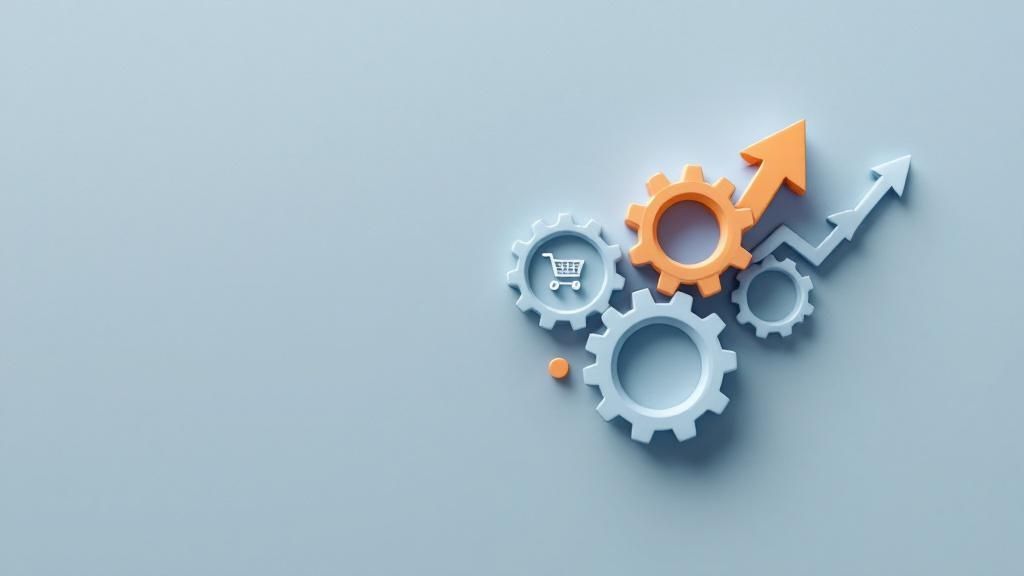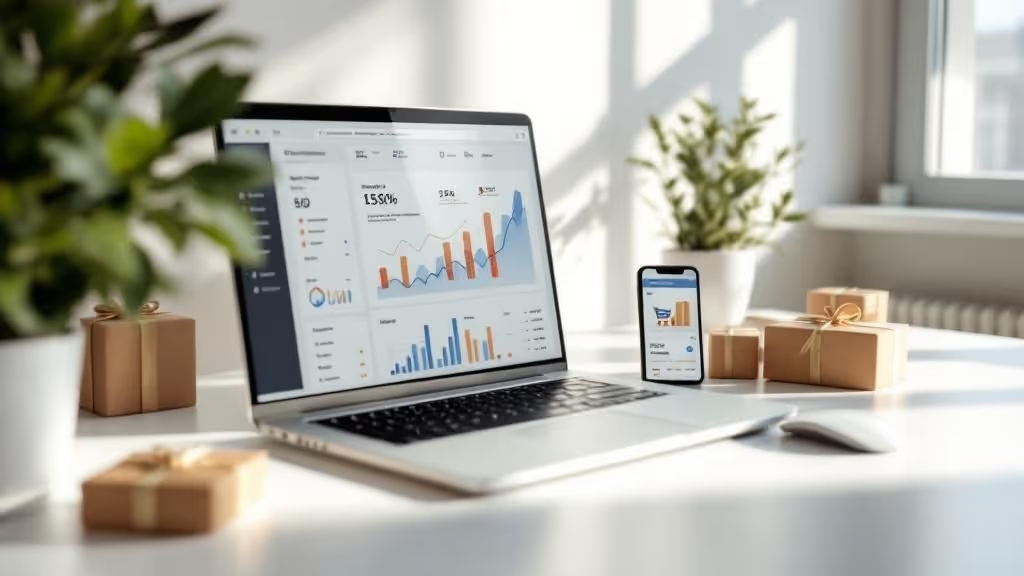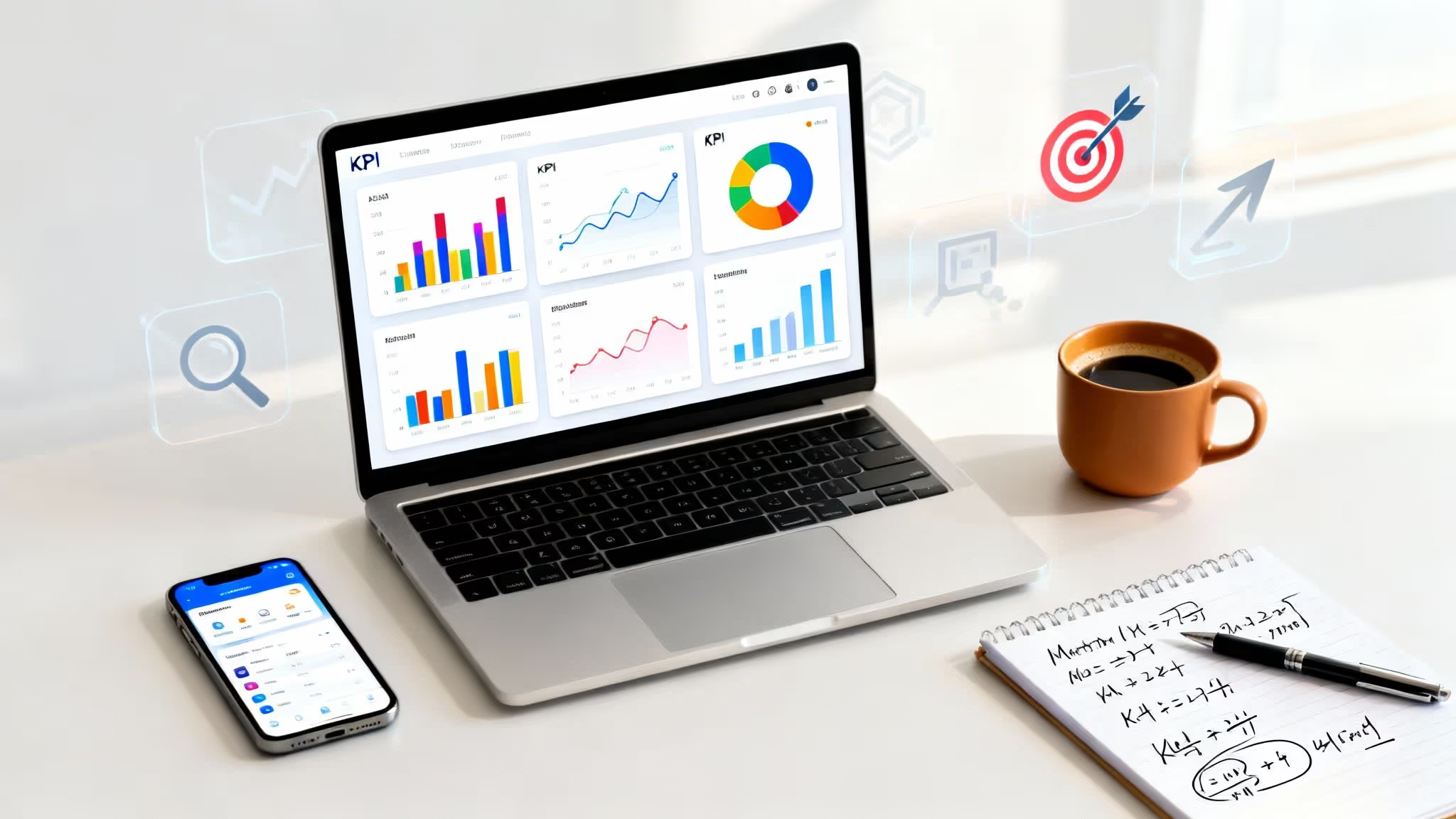When you hear "PPC for e-commerce," we're talking about using paid ad platforms like Google Ads to place your products directly in front of people who are ready to buy. It’s a direct line to your online store, designed for one thing: generating immediate, measurable sales. This strategy allows you to bypass the slow climb of organic search and connect with shoppers the moment they decide they need what you're selling.
Why PPC Is Your E-commerce Growth Engine

In a crowded online marketplace, waiting for organic traffic to find you is a slow-burn strategy. While a solid SEO foundation is crucial for long-term brand health, Pay-Per-Click (PPC) advertising delivers the speed and control ambitious e-commerce brands need to scale effectively.
Think of it this way: SEO is like building your flagship retail store. It’s a powerful asset that builds value and authority over time. PPC, on the other hand, is like setting up a pop-up shop in Times Square during New Year's Eve—you get an instant flood of high-intent shoppers.
Immediate and Targeted Visibility
The primary advantage of PPC is speed. You can launch a campaign and, within hours, see your products at the top of Google's search results, appearing at the exact moment a potential customer is searching.
It’s not just about being seen; it’s about being seen by the right people. The targeting capabilities are incredibly precise. You can zero in on customers based on:
- Specific Search Queries: Target high-intent, long-tail keywords. Think "women's vegan leather crossbody bag," not just "handbags."
- Demographics: Pinpoint your ad spend on the exact age, gender, or location that defines your ideal customer.
- Past Behavior: Use remarketing to bring back shoppers who browsed your site or abandoned a cart—a powerful second chance to make a sale.
To understand how these traffic sources fit into a broader strategy, it's helpful to see them side-by-side. Each plays a distinct yet complementary role in driving sustainable growth.
PPC vs Organic Traffic: A Strategic Snapshot for E-commerce
This table shows that it's not a question of if you should use one or the other, but how to make them work in tandem. PPC delivers quick wins and valuable data, while organic builds foundational strength.
A Powerful Data and Testing Ground
PPC is more than an ad channel; it's a real-time market research tool. Unsure about a new product line? Instead of ordering thousands in inventory, launch a small, targeted PPC campaign. The resulting click and conversion data provide fast, honest feedback from the market.
A smart PPC strategy isn't just another expense—it's a direct investment in your store's profitability. It provides the actionable data needed to make smarter business decisions, from product development to promotional calendars.
This approach lets you test everything: pit different ad headlines against each other, A/B test landing pages, or compare offers like "15% off" vs. "free shipping." The performance metrics will tell you precisely what resonates with your customers. This is how you start to understand the direct impact of PPC on the numbers that matter most.
Measurable Results and Scalability
With PPC, every dollar is accountable. You can track your Return on Ad Spend (ROAS) with impressive accuracy, connecting specific ad clicks directly to revenue. This level of measurability is a significant advantage.
Given that businesses typically see $2 in revenue for every $1 spent on paid ads, it's clear why this channel is so popular. Once you identify a winning formula—the right mix of keywords, ad creative, and landing pages that yields a profitable ROAS—you can scale with confidence. This predictable, scalable model is what transforms PPC from a simple advertising tactic into a genuine growth engine for your e-commerce business.
Building Your E-commerce PPC Foundation Right
Diving into PPC without a solid plan is a recipe for burning through your budget with little to show for it. A strong foundation isn't just a "nice-to-have"; it's the most critical factor separating profitable campaigns from expensive experiments.
Getting this right means making smart, strategic decisions before you spend your first dollar. It all starts with one question: What are you trying to achieve? Whether you're clearing out old inventory, launching a new product line, or aiming for a specific Return on Ad Spend (ROAS), your answer will shape every subsequent step.
Choosing the Right Platforms and Defining Your Goals
While Google Ads is the leader in search, a smart ppc for e-commerce strategy diversifies its channels. The ideal platform depends on your products and your target audience.
- Microsoft Advertising: Often overlooked, this platform can offer lower competition and cheaper clicks. Its audience tends to be more professional, which might be perfect for your brand.
- Meta Ads (Facebook & Instagram): This is your playground for visually appealing products. It’s phenomenal for creating demand and reaching people before they even start searching.
- Pinterest & TikTok: These platforms are gold for brands in niches like fashion, home decor, or DIY. They are built for discovery and influencing future buying decisions.
Once you’ve selected your platforms, your goals must be specific. "Increase sales" is a wish. A better, actionable objective is, "Achieve a 4:1 ROAS on our new sneaker collection within 90 days." This clarity turns a vague task into a focused business operation.
Structuring Campaigns for Profit, Not Just Products
A common mistake is structuring campaigns based on product categories. An effective setup goes deeper, organizing campaigns around profit margins and customer intent. This is where you gain a real competitive edge.
For instance, if you sell outdoor gear, don't lump all your boots into one campaign. A search for "women's waterproof hiking boots" signals a buyer is ready to purchase and will likely pay for specific features. This search deserves its own ad group with hyper-targeted copy and a more aggressive bid.
In contrast, a search like "stylish ankle boots" is broader. This person is likely browsing or hunting for a deal. They require different messaging—perhaps highlighting a sale or a unique design—and you'd start with a more conservative bid.
A scalable, logical campaign structure is your most powerful tool. By segmenting based on intent and margin from day one, you build a system that allows you to allocate budget intelligently, maximizing profitability across your entire product catalog.
This foundational approach prevents overspending on low-margin products and ensures you invest heavily in your most profitable opportunities.
Setting Budgets and ROAS Targets
With a solid structure in place, it's time to define your budget and ROAS targets. This flowchart breaks down a simple yet effective way to calculate your daily ad spend based on profitability goals.

As shown, smart budgeting isn't about picking a random number. It starts with your end goal (your target ROAS) and works backward to determine a daily spend that makes business sense.
Making Sure Your Tracking Tells the Whole Story
Finally, none of this strategy matters if your tracking is flawed. The cornerstone of any successful ppc for e-commerce setup is accurate, comprehensive conversion tracking. This goes beyond simply counting sales.
You absolutely must measure:
- Revenue: How much money did each campaign, ad group, or keyword actually generate?
- Return on Ad Spend (ROAS): Is your ad spend profitable? This is your ultimate North Star metric.
- Conversion Value: You must assign dynamic values to your conversions. This is how you differentiate a $20 sale from a $200 sale in your reporting.
With these foundational pieces—clear goals, the right platforms, a profit-driven structure, and rock-solid tracking—you are prepared to build and manage PPC campaigns that don’t just bring clicks, but consistently drive real revenue growth.
Mastering Keywords and Ad Copy That Actually Sells

A great campaign structure is a vital first step, but the magic happens when you connect with a customer through the exact words they're searching for and the ad you present. This is where we move beyond technical setups and into the two elements that directly drive clicks and sales: keywords and ad copy.
A winning ppc for e-commerce strategy is built on a deep understanding of customer intent.
Moving Beyond Basic Keywords
It’s tempting to use broad, generic keywords, but they often attract low-quality clicks from people who are "just looking." The real value lies in long-tail keywords. These longer, hyper-specific phrases indicate a user isn't just browsing—they're ready to buy.
Consider the difference in intent:
- Broad Keyword: "sofa" (Is this person looking for design ideas, cleaning tips, or a local store? The intent is unclear.)
- High-Intent Keyword: "3-seater grey velvet sectional sofa" (This person knows exactly what they want. They’re shopping.)
By focusing on specific, high-intent terms, your ad becomes the perfect solution at the perfect moment. This shift drastically reduces wasted ad spend and places your product in front of someone actively looking to make a purchase.
Crafting E-commerce Ad Copy That Resonates
Once you've targeted the right person with the right keyword, your ad copy has one job: get the click. Generic copy is easily ignored. Your ad must speak the language of an online shopper by immediately highlighting what they care about most.
Your ad is a miniature sales pitch. It needs to quickly answer the customer's two biggest questions: "Is this the right product for me?" and "Why should I buy it from this store?"
To cut through the noise, leverage your unique selling propositions (USPs). What makes buying from you the obvious choice?
- Free & Fast Shipping: If you offer it, feature it prominently. This is a massive conversion driver.
- Hassle-Free Returns: You're selling confidence, not just a product. This removes risk for the buyer.
- Limited-Time Offers: A little urgency goes a long way. Phrases like "Sale Ends Friday" or "20% Off Today Only" encourage immediate action.
- Product Specifics: Be specific. Include key details like material, size, or compatibility in the headline to pre-qualify the click.
For example, a headline like "Shop Sofas Online" is forgettable. But "Grey Velvet Sectionals | Free 2-Day Shipping | Shop Now" is specific, highlights a powerful benefit, and provides a clear call to action. That’s an ad that sells.
Maximizing Your Real Estate with Ad Extensions
Standard text ads offer limited space. Ad extensions are your secret weapon for dominating the search results page. They allow you to add extra information and valuable links, making your ad bigger, more informative, and far more clickable. Using them is non-negotiable for a modern ppc for e-commerce strategy.
For online stores, a few extensions are essential:
By layering these extensions, you not only give users more reasons to click but also physically push your competitors' ads further down the page. It’s a smart way to boost your ad’s visibility and click-through rate.
Optimizing Campaigns for Maximum Profitability
https://www.youtube.com/embed/j8pxmNrdJvw
Getting your campaigns live is the starting line, not the finish. The real work—and profit—comes from relentless, data-driven optimization. This is how you transform an ad campaign from a budget item into a powerful growth engine for your store.
The goal isn't to be perfect on day one. It's to be smarter today than you were yesterday by diving into your data, understanding what it’s telling you, and taking decisive action.
Uncover Hidden Waste with Search Term Reports
One of the most powerful tools in your arsenal is the search term report. This report shows you the exact queries people typed into Google before clicking your ad. It's an unfiltered look into your potential customer's mind and your biggest opportunity to slash wasted spend.
Let's say you sell high-end leather work boots. Your report shows clicks from searches like "free leather boot patterns" or "how to repair leather boots." These clicks cost you money with almost zero chance of converting.
This is where negative keywords become your best friend. By adding terms like “free,” “patterns,” and “repair” to your negative keyword list, you instantly prevent your ads from showing for those irrelevant searches. Regularly mining your search term report for these budget-draining queries is a fundamental practice for any profitable e-commerce PPC account.
Choose Your Bidding Strategy Wisely
Your bidding strategy is a critical decision that directly shapes campaign profitability. You have a spectrum of options, from full manual control to completely automated strategies. The right choice depends on your campaign's age, its data volume, and your objectives.
- Manual CPC: This offers the most control. You set the maximum bid for every keyword yourself. It’s ideal for new campaigns where you're gathering data, but it becomes time-consuming to manage at scale.
- Enhanced CPC (eCPC): A hybrid approach. You set manual bids, but you give Google leeway to adjust them up or down if it believes a click is more or less likely to convert. It's a great first step away from pure manual bidding.
- Target ROAS (Return on Ad Spend): For e-commerce, this is where automation excels. You tell Google your desired return—for example, a 400% ROAS ($4 in revenue for every $1 in ad spend). The algorithm then automates your bids to hit that target. This strategy needs significant conversion data to work well, so it’s best for more mature campaigns.
A word of caution: Don't rush into automated bidding like Target ROAS. A campaign needs at least 30-50 conversions over a 30-day period for the algorithm to have enough data to make smart decisions. Enabling it too early can hurt performance.
Switching to an automated strategy isn't a "set it and forget it" move. You still need to monitor performance and be ready to adjust your ROAS targets based on business goals and inventory levels.
The Critical Role of Your Landing Page
You can have the most brilliantly optimized ad campaign, but if it sends traffic to a slow or confusing landing page, you're just throwing money away. The journey from ad click to checkout must be seamless.
This connection between your ad and your page directly impacts more than just your conversion rate; it's a huge factor in your Quality Score. A high Quality Score is Google's way of rewarding you for a great user experience, resulting in lower ad costs and better ad positions.
Here’s what to focus on:
- Message Match: The headline and offer on your landing page must perfectly match the ad copy. If your ad promises "50% Off Running Shoes," that exact deal better be front and center on the page.
- Page Speed: E-commerce shoppers are impatient. A page that takes more than a couple of seconds to load will see a massive drop-off. Use Google's PageSpeed Insights to diagnose and fix issues.
- Mobile-First Design: With most e-commerce traffic on mobile, your product pages must be flawless on a small screen. Ensure buttons are easy to tap and forms are simple to complete.
- Clear Call-to-Action (CTA): Is your "Add to Cart" button big, bold, and impossible to miss? Don't make users hunt for the most important button on the page.
Optimizing landing pages is a continuous process. You can explore best practices to boost your ecommerce PPC ROI, which often start right on your own website. Making these data-backed decisions is what separates stagnant campaigns from those that achieve incredible profitability.
Taking Your E-commerce PPC to the Next Level

Once your campaigns are consistently profitable, it's time to pull away from the competition. Top-tier e-commerce stores do this by embracing more sophisticated campaign types to capture more market share and build a resilient ad strategy.
A truly effective PPC for e-commerce strategy uses a mix of campaign formats to reach customers at every stage of their buying journey. This means mastering platforms built for product sales and, just as importantly, winning back shoppers who have already shown interest.
Dominate the SERP with Google Shopping and Performance Max
If you sell physical products online, Google Shopping is essential. These visual ads appear at the top of the search results, showing your product image, price, and brand before a user even clicks. They are game-changers for grabbing high-intent buyers.
Google’s Performance Max (PMax) campaigns push this even further. PMax is an all-in-one campaign type that automates your ads across Google's entire network—Shopping, YouTube, Display, Search, and more. While you give up some granular control, its machine learning is incredibly effective at finding converting customers in unexpected places.
To make these tools work for you, focus on:
- A Flawless Product Feed: Your product feed is the engine for both Shopping and PMax. Your titles must be descriptive, images top-notch, and pricing accurate. This data directly fuels campaign performance.
- Smart Product Segmentation: Don't dump all your products into one campaign. A savvier approach is to segment them into separate campaigns for best-sellers, low-margin items, or seasonal products. This gives you more precise control over budgets and ROAS targets.
- Strong Creative Assets: For PMax to work its magic, you must supply it with high-quality images, clean logos, and engaging video clips. The algorithm will mix and match these to create the best-performing ads for each platform.
Performance Max represents a fundamental shift in managing e-commerce PPC. It's less about tweaking individual bids and more about strategic oversight—feeding the algorithm the right data, assets, and business goals to steer it toward profitability.
Win Back Lost Sales with Strategic Remarketing
Most people won't buy on their first visit. This isn't a failure; it's an opportunity. Strategic remarketing is one of the most profitable activities you can undertake. It allows you to re-engage people who visited your site, viewed specific products, or abandoned their shopping cart.
Think of it as your second chance to close the deal. A shopper who added boots to their cart but got distracted is a warm lead. You can create a specific ad showing them those exact boots, perhaps with a nudge like "10% Off to Complete Your Order."
Remarketing is also fantastic for turning one-time buyers into loyal customers. Someone who bought hiking boots six months ago is a great candidate for ads featuring waterproof socks or related gear. This is how you increase customer lifetime value. Understanding how PPC marketing can help in your market expansion is crucial for growth, and remarketing is a huge piece of that puzzle.
Adopting a Mobile-First PPC Mindset
The shift to mobile commerce is already here. Your customers are researching, comparing, and buying on their phones. If your PPC strategy isn't built for mobile, you're invisible to a massive segment of your audience.
An incredible 73% of all e-commerce sales are expected to happen on mobile devices by 2025. This reality is reflected in ad spend, which is projected to hit an average of $58.21 per internet user in search alone. These numbers demand a sharp, mobile-focused strategy.
This means your product pages must load instantly on a phone, your checkout must be simple to use with a thumb, and your ads need to be designed for small screens. Always preview how your ad copy and extensions look on a mobile device. The brands that will dominate in the coming years are those creating a seamless and persuasive experience for the shopper on the go.
Common Questions About E-commerce PPC
As you dive deeper into managing paid search, you'll inevitably encounter roadblocks. This is a good sign—it means you're asking the right questions. Let's tackle some of the most common issues e-commerce store owners face.
How Much Should I Spend on E-commerce PPC?
There’s no magic number. Instead of fixating on a budget, tie your spending directly to profitability. The best way to start is by calculating your break-even Return on Ad Spend (ROAS).
It's simpler than it sounds. If you sell a product for $100 and your profit is $30, you can spend up to $30 on ads to get that sale and still break even. Your break-even ROAS is 333% ($100 revenue / $30 ad spend). Any ROAS above that is pure profit.
Instead of asking, "How much should I spend?" the real question is, "What ROAS do I need to be profitable?" I advise clients to start with a modest daily budget they're comfortable with—something like $25 to $50 per day. Prove you can hit your target ROAS first. Once you have, you can scale up your ad spend with confidence.
Why Are My Ads Getting Clicks but No Sales?
This is a frustrating issue that almost always points to a gap between what your ad promises and what your landing page delivers. Your ad wrote a check that your website couldn't cash.
First, dig into your search terms report to ensure you're not paying for irrelevant clicks. If the traffic is relevant, the problem is likely on your product page.
Here’s a quick diagnostic checklist:
- Page Load Speed: Is your page loading in under 3 seconds? Slower speeds cause visitors to leave before they even see your product.
- Price and Shipping Shock: Is the price clear? Are you surprising customers with high shipping costs at the last second of checkout? That’s a conversion killer.
- Ad-to-Page Scent: Does the product on the page perfectly match the one in the ad? If the ad showed a blue shirt and the page defaults to red, you've created friction and doubt.
A high click-through rate with poor conversions is a major red flag. It indicates the ad is working, but the on-site experience is failing.
Should I Use Google Shopping or Standard Search Ads?
For almost any e-commerce store, the answer is a resounding both. They complement each other by covering different stages of the buyer's journey. Relying on just one leaves a serious gap in your marketing funnel.
Google Shopping AdsThese visual ads are fantastic for grabbing the attention of shoppers ready to buy. They see the product image and price before they click, which pre-qualifies them.
Standard Search AdsThese classic text ads are your secret weapon for targeting broader, problem-focused keywords. They help you get in front of customers earlier in their research. Someone searching "best running shoes for flat feet" is a perfect opportunity for a search ad to build awareness and introduce your brand as the solution.
A solid strategy uses both. Search ads pull people in during their initial research, and then Google Shopping ads and remarketing campaigns are there to close the deal when they’re ready to buy.
Ready to stop guessing and start growing? The experts at Twelverays build data-driven PPC campaigns that deliver measurable results, turning your ad spend into real revenue. Learn how we can optimize your e-commerce performance today.





